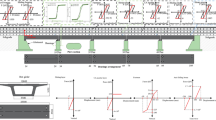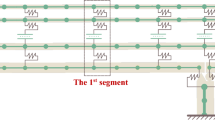Abstract
Ballasted track is the most common track model in railway system and earthquake would be a great threaten for train running safety. This study investigates derailment features and lateral displacement response of the train-ballasted track-subgrade system subjected to earthquake using 1-g shaking table. The model was loaded using scaled Zhengzhou Huanghe Qiaozhi (ZHQ) earthquake wave, ALS earthquake and CHY004 earthquake which are with variable-characters. It is observed that current stopping threshold for train is conservative because derailment factor is less than 0.8. The derailment factor of train increase with increasing acceleration amplitude and the critical derailment condition of train under ZHQ earthquake, ALS earthquake and CHY004 earthquake is 0.18 g, 0.15 g and 0.15 g, respectively. The lateral displacement of rail is negligible compared with that of wheel. Lower-frequency earthquake would cause larger derailment factor with derailment analysis and displacement analysis. The maximum peak lateral displacement of wheel under critical derailment condition is significant, which means train safety is under a great danger.
Similar content being viewed by others
References
Brand L (1957) The Pi theorem of dimensional analysis. Archive for Rational Mechanics and Analysis 1:35–45, DOI: https://doi.org/10.1007/BF00297994
Cheng YC, Hsu CT (2016) Derailment safety analysis for a tilting railway vehicle moving on irregular tracks shaken by an earthquake. Proceedings of the Institution of Mechanical Engineers, Part F. Journal of Rail and Rapid Transit 230(3):625–642, DOI: https://doi.org/10.1177/0954409714553255
Curtis WD, Logan JD, Parker WA (1982) Dimensional analysis and the pi theorem. Linear Algebra and its Applications 47:117–126, DOI: https://doi.org/10.1016/0024-3795(82)90229-4
Esmaeili M, Noghabi HH (2013) Investigating seismic behavior of ballasted railway track in earthquake excitation using finite-element model in three-dimensional space. Journal of Transportation Engineering 139(7):697–708, DOI: https://doi.org/10.1061/(asce)te.1943-5436.0000535
GB/T 17742-2008 (2008) The Chinese seismic intensity scale. GB/T 17742-2008, China Standard Press, Beijing, China
Jin Z, Pei S, Li X, Liu H, Qiang S (2016) Effect of vertical ground motion on earthquake-induced derailment of railway vehicles over simply-supported bridges. Journal of Sound and Vibration 383:277–294, DOI: https://doi.org/10.1016/j.jsv.2016.06.048
Jing GQ (2012) Railway ballasted track. China Railway Publishing House, Beijing, China
Ju SH, Li HC (2011) Dynamic interaction analysis of trains moving on embankments during earthquakes. Journal of Sound and Vibration 330(22):5322–5332, DOI: https://doi.org/10.1016/j.jsv.2011.05.032
Koyama S, Kashima T, Okawa I, Iiba M, Morita K (2005) Characteristics of earthquake ground motion during the aftershocks of the Mid Niigata Prefecture Earthquake in 2004. Proceedings of the 37th joint meeting of US-Japan panel on wind and seismic effects, UJNR, May 16–18, Tsukuba, Japan
Kumakura T, Ishii H, Konishi T (2010) Seismic assessment of ballasted tracks in large-scale earthquakes. JR East Technical Review 17:25–28
Miyamoto T, Matsumoto N, Sogabe M, Shimomura T, Nishiyama Y, Matsuo M (2004) Railway vehicle dynamic behavior against large-amplitude track vibration. Quarterly Report of RTRI 45(3):111–115, DOI: https://doi.org/10.2219/rtriqr.45.111
Miyamoto T, Matsumoto N, Sogabe M, Shimomura T, Nishiyama Y, Matsuo M (2007) Full-scale experiment on the dynamic behavior of railway vehicles against heavy track vibration. Journal of Environment and Engineering 2(2):419–428, DOI: https://doi.org/10.1299/jee.2.419
Nishimura K, Terumichi Y, Morimura T, Fukada J (2010) Experimental study on the vehicle safety by earthquake track excitation with 1/10 scale vehicle and roller rig. Journal of System Design and Dynamics 4(1):226–238, DOI: https://doi.org/10.1299/jsdd.4.226
Q/CR 633-2018 (2018) Technical conditions for earthquake early warning and monitoring system for high-speed railways. Q/CR 633-2018, China Railway Publishing House, Beijing, China
Sogabe M, Asanuma K, Tokunage M (2013) Deformation behavior of ballasted track during earthquakes. Quarterly Report of RTRI 54(2):104–111, DOI: https://doi.org/10.2219/rtriqr.54.104
Tanabe M, Matsumoto N, Wakui H, Sogabe M, Okuda H, Tanabe Y (2008) A simple and efficient numerical method for dynamic interaction analysis of a high-speed train and railway structure during an earthquake. Journal of Computational and Nonlinear Dynamics 3(4), DOI: https://doi.org/10.1115/1.2960482
Tanabe M, Wakui H, Sogabe M, Matsumoto N, Tanabe Y (2010) A combined multibody and finite element approach for dynamic interaction analysis of high-speed train and railway structure including post-derailment behavior during an earthquake. IOP Conference Series: Materials Science and Engineering 10(1):012144, DOI: https://doi.org/10.1088/1757-899x/10/1/012144
TB 10621-2014 (2014) Code for design of high-speed railway. TB 10621-2014, China Railway Publishing House, Beijing, China
TB/T 2489-2016 (2016) Wheel-rail horizontal force and vertical force ground test method. TB/T 2489-2016, China Railway Publishing House, Beijing, China
Wu X, Chi M, Gao H (2016) Post-derailment dynamic behavior of a high-speed train under earthquake excitations. Engineering Failure Analysis 64:97–110, DOI: https://doi.org/10.1016/j.engfailanal.2016.03.005
Zhao X (2010) The model test research of longitudinal force for welded turnout on bridge. MSc Thesis, Southwest Jiaotong University, Chengdu, China (in Chinese)
Acknowledgements
The authors gratefully acknowledge the financial support provided by R&D Program of China Railway Science (2017T001-I), Technology Plan Project of Sichuan Province (18MZGC0186, 18MZGC0247), National Key Research and Development Plan of China (2017YFC0504901), Doctoral Innovation Fund Program of Southwest Jiaotong University (D-CX201703) and the State Scholarship Fund of Studying Abroad (201707000161).
Author information
Authors and Affiliations
Corresponding author
Rights and permissions
About this article
Cite this article
Cao, L., Yang, C. & Zhang, J. Derailment Behaviors of the Train-Ballasted Track-Subgrade System Subjected to Earthquake Using Shaking Table. KSCE J Civ Eng 24, 2949–2960 (2020). https://doi.org/10.1007/s12205-020-0005-6
Received:
Revised:
Accepted:
Published:
Issue Date:
DOI: https://doi.org/10.1007/s12205-020-0005-6




